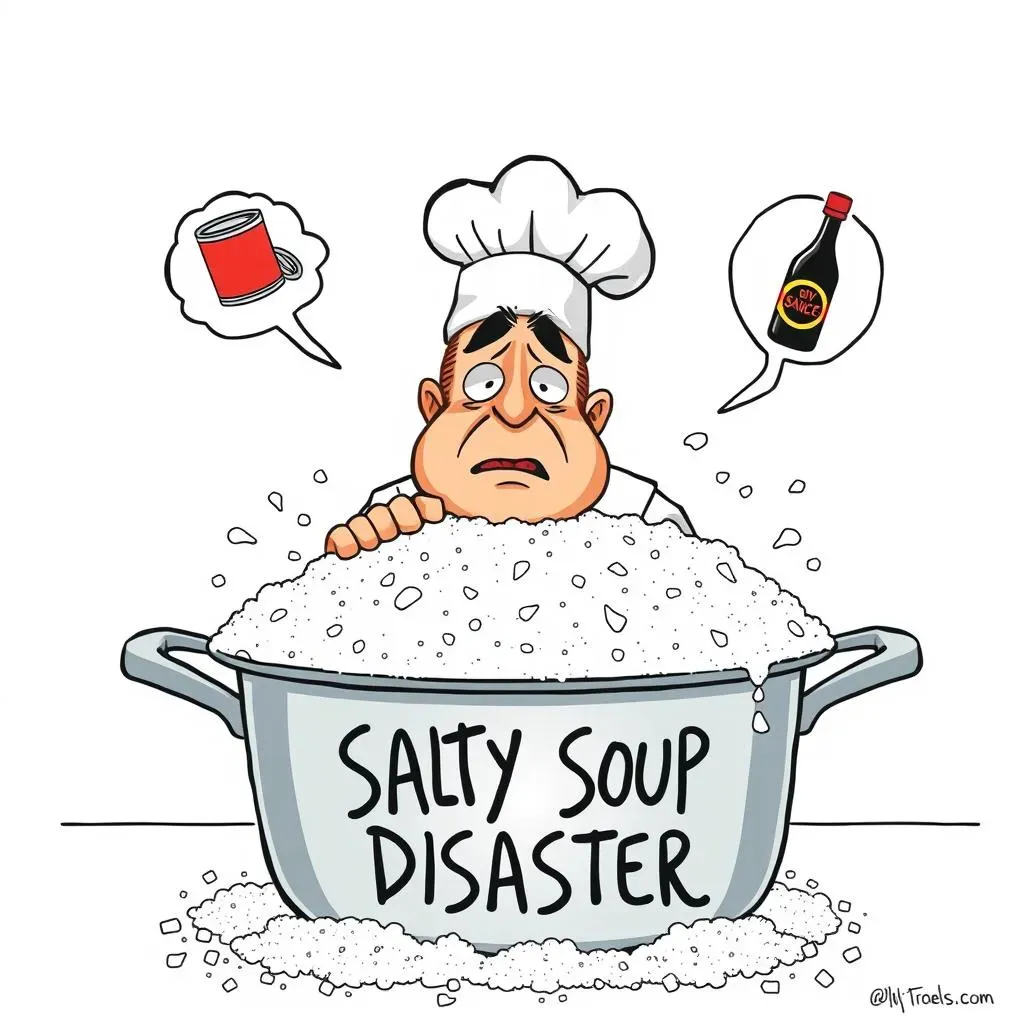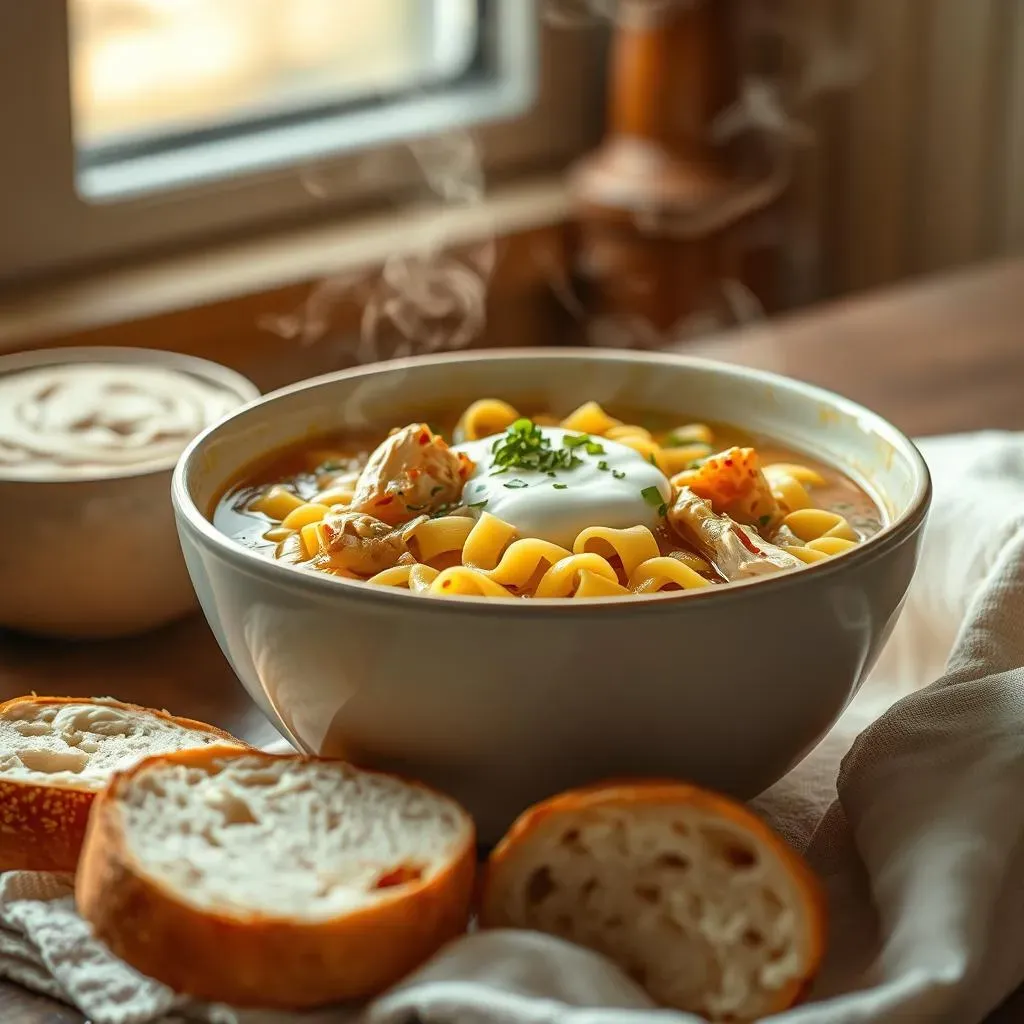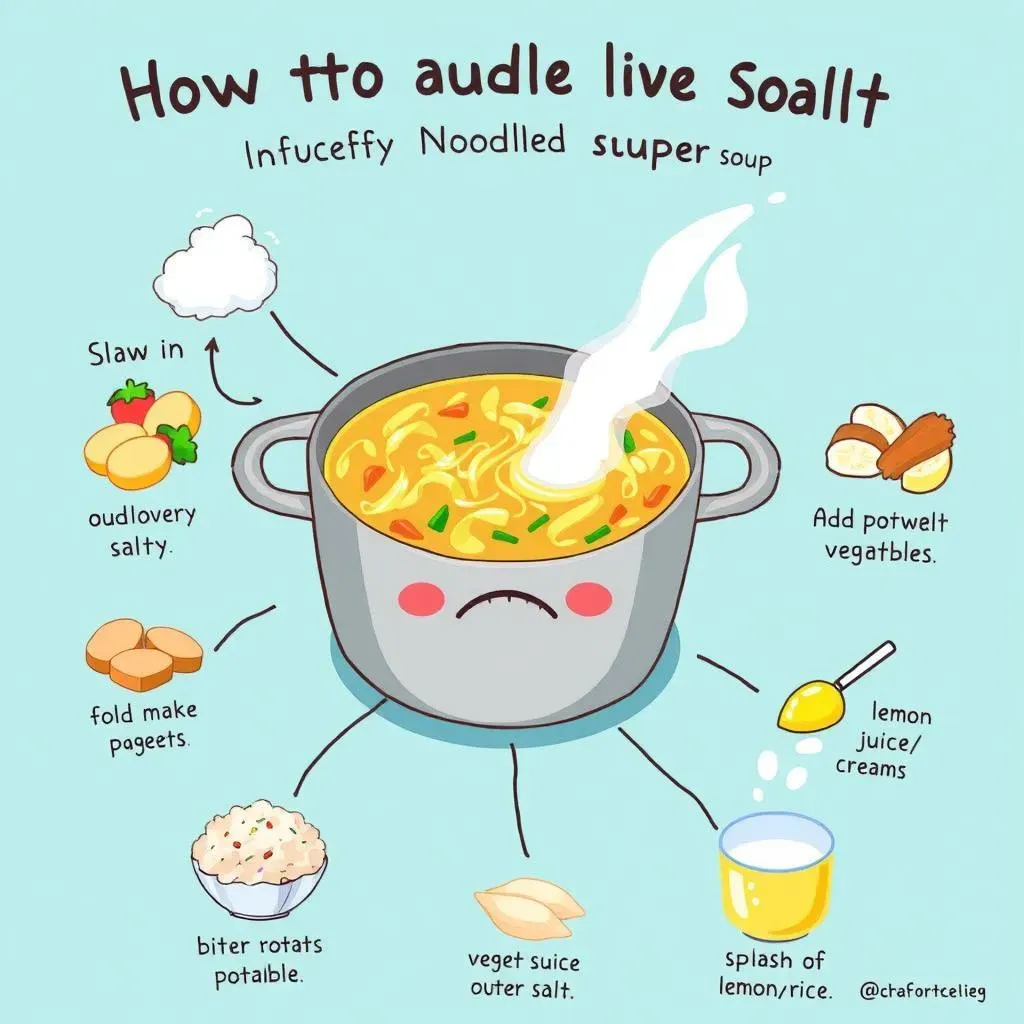Table of Contents
Ever made a batch of chicken noodle soup, only to find it's saltier than the Dead Sea? It's a kitchen bummer, I know, I’ve been there, spoon in hand, staring at a pot of what was meant to be comfort, but is now a salt lick. You're not alone! Over-salting is a common cooking mishap, and thankfully, there are ways to fix it. This article isn't about shaming your seasoning skills. Instead, we’re diving into practical, easy-to-follow methods on how to reduce salt in chicken noodle soup. We'll explore simple fixes you can try right now, like adding a splash of something tangy or a dollop of something creamy. We'll also look at some of the more interesting, slightly out-there techniques that have been floating around the internet, including the controversial potato trick. By the end, you'll have a toolbox of ideas to rescue your salty soup. So, grab your apron, let's get started, and turn that salty soup into something delicious.
The Salty Soup Situation: Why it Happens

The Salty Soup Situation: Why it Happens
The Accidental Over-Pour
Okay, so you’ve got a salty soup on your hands. First things first, let's not beat ourselves up about it. It happens to the best of us. Sometimes, it’s a simple case of the hand slipping while pouring the salt in, you know, that moment when you’re not quite paying attention and suddenly, whoops, a mini salt avalanche. Or, maybe you're using a new type of salt, and it's way saltier than what you're used to. I once used sea salt for the first time, and it was like a salt bomb exploded in my pot! It's easy to misjudge, especially if you're multi-tasking in the kitchen, which, let's be honest, is pretty much always.
Another sneaky culprit is relying on pre-made broths or stocks. These can be packed with sodium, and if you’re not careful, it can quickly push your soup over the edge. I always recommend checking the labels, but who has time for that while juggling a million other things? And sometimes, we just get carried away with the seasoning, thinking more is better, when in reality, it’s a delicate balance, like a tightrope walker trying to hold all of the seasoning at the same time. It’s a learning curve, and the first step is admitting that over-salting is a common blunder.
The Hidden Sodium Suspects
Beyond the obvious salt shaker, there are other hidden sources of sodium lurking in our ingredients. Canned vegetables, for instance, can be surprisingly high in sodium, and sometimes, the sodium is there to preserve them. It’s like they’re secretly plotting to make your soup saltier than it needs to be. Even some types of cheese, bacon, or cured meats that you might add for flavor can contribute to the overall saltiness. It's like adding more salt on top of the salt, which is a recipe for disaster, or at least, a very salty soup. I once made a soup with some leftover bacon, and it was a salt mine, I tell you.
And don't even get me started on soy sauce or other salty condiments. They can sneak into a recipe without you even realizing it, and before you know it, your soup is practically swimming in salt. The lesson here? Always be mindful of every ingredient you toss into the pot. It’s like being a detective, you have to be on the lookout for those hidden sodium clues. And if you’re not careful, that sodium can cause some serious flavor chaos.
Common Culprits | Why They Add Salt |
|---|---|
Pre-made Broths/Stocks | Often contain high levels of sodium for preservation and flavor. |
Canned Vegetables | Sodium is used as a preservative. |
Soy Sauce/Salty Condiments | Naturally high in sodium, used for flavoring. |
Cheese, Bacon, Cured Meats | High in salt content, adds flavor, but can increase sodium. |
Easy Ways to Fix Overly Salty Chicken Noodle Soup

Easy Ways to Fix Overly Salty Chicken Noodle Soup
The Dairy Savior
Alright, so your soup tastes like the ocean, don’t worry, it’s time to call in the dairy cavalry! Adding a bit of dairy can work wonders. Think of it like this, it’s like adding a creamy blanket to mellow out the saltiness. A swirl of yogurt, a splash of milk, or even a dollop of sour cream can do the trick. The fat in the dairy helps to balance the salt and add a touch of richness. It’s like a magic trick, but with milk instead of a rabbit. I usually go for a little full-fat Greek yogurt because it adds a nice tang as well. It's a quick fix and a tasty way to rescue your meal.
Now, if you don't have any dairy on hand, don't sweat it. There are other options. Remember that time I added a bit of coconut milk to my soup? It was a total game-changer, and it gave it a slightly sweet flavor. So, don't be afraid to experiment with what you have in your fridge. It’s a good way to give your soup a whole new flavor profile while rescuing it from the salt monster. Just remember, start small, add a little at a time, and taste as you go. You don't want to overdo it and end up with a creamy soup that tastes like it’s from a dessert.
The Dilution Solution
Okay, let's talk about the dilution method, which is basically like adding more water to the pool. This is a pretty straightforward approach. You are just adding more liquid to spread out the salt, making it less intense. The easiest way to dilute is to add more water, but if you do that, you might lose some of the flavor of your soup. So, a better option is to add some unsalted chicken broth or stock. It’ll add more liquid without diluting all the delicious chicken flavors you've worked so hard to build up. It's like giving your soup a little extra room to breathe.
Now, here's a little tip: add the liquid gradually. You don’t want to add too much and end up with a soup that is as thin as water. Start with a small amount, stir it in, and then taste. If it’s still too salty, add a bit more. It's kind of like a balancing act. You're trying to get the salt level just right, and it might take a couple of tries. But trust me, it’s better to go slow and get it right than to over-dilute and end up with a watery mess. It’s all about finding that sweet spot, or in this case, that non-salty spot.
Method | How it Works | Tips |
|---|---|---|
Dairy | Fat balances salt, adds richness. | Start small, use full-fat for better results. |
Dilution | Adds more liquid, reducing salt concentration. | Use unsalted broth/stock, add gradually. |
The Balancing Act
Sometimes, the best way to fix a salty soup isn't to remove the salt, but to balance it out. Think of it like a seesaw, you add something to the other side to even things out. A little bit of acidity can make a huge difference. A squeeze of lemon juice, a splash of cider vinegar, or even a dash of hot sauce can cut through the saltiness and bring out other flavors. It's like a secret ingredient that wakes up the taste buds and makes your soup sing. I once added a tiny bit of lime juice to my soup, and it was like a flavor explosion!
Also, adding a touch of sweetness can also help. A pinch of sugar or a drizzle of honey can round out the flavors and make the salt less noticeable. It's like a friendly hug for your tongue. You don't need much, just a little bit to balance things out. It's all about finding the right combination of flavors that work together. So, don't be afraid to experiment with different acidic and sweet ingredients. It's like being a flavor chemist, mixing and matching until you get the perfect result. You might be surprised at how a little bit of this and a little bit of that can turn a salty soup into a masterpiece.
Advanced Techniques to Reduce Salt in Chicken Noodle Soup

Advanced Techniques to Reduce Salt in Chicken Noodle Soup
The Curious Case of the Potato
Alright, let's get into some of the more, shall we say, *interesting* methods for tackling salty soup. First up, we have the legendary potato trick. The idea here is that you toss a peeled potato (or two, depending on how salty we're talking) into your soup and let it simmer for a while. The potato, in theory, acts like a sponge, soaking up some of the excess salt. Now, I've tried this myself, and I'll be honest, the results are, let's just say, not always consistent. Sometimes it works like a charm, and other times, I'm left wondering if the potato just took a bath in my soup. It's a bit of a kitchen mystery, really, like trying to understand why socks disappear in the dryer. Some people swear by it, others are skeptical, but hey, it’s worth a shot, right? Just remember to remove the potato before serving, unless you want to add a starchy surprise to your bowl.
Now, if the potato feels too basic, some folks suggest using other veggies, like a chunk of rutabaga, which is said to be a salt-absorbing superstar. The principle is the same: let the veggie simmer and do its thing. The thing about these methods is, they're not always a guaranteed fix, it really depends on how salty your soup is. But they can help, especially if you're working with a mild case of over-salting. It's like having a team of veggie superheroes ready to fight against the salt monster, and sometimes, that's exactly what you need to save the day. It's all about experimenting, and finding what works best for you, and your soup.
The Rinsing Rescue
Okay, this technique is a bit more involved, but it can be quite effective, especially if you're dealing with a really salty soup. The idea here is to remove the solids from your soup – that’s the chicken, the noodles, the veggies – and give them a good rinse under warm water. Now, I know this might sound a bit crazy, like giving your soup ingredients a shower, but trust me, it can help. You're essentially washing off the excess salt that's clinging to them. After you’ve rinsed everything, put them back in the pot with the remaining broth and you might notice a big difference. It's like giving your ingredients a fresh start, and sometimes, that's all they need.
Now, this method isn’t for the faint of heart, it does take some time and effort. It’s also not ideal if your noodles are already super soft, they might turn to mush when you rinse them. But if you have a particularly salty soup, and you’re willing to put in the effort, it can be a real lifesaver. It’s like giving your soup a spa treatment, and who doesn’t want that? Just remember to be gentle with your ingredients, and don't let them sit out for too long, you want them to be warm and cozy when they go back into the pot. It's all about the details, and sometimes, a little bit of extra work can make a big difference.
Technique | How it Works | Things to Consider |
|---|---|---|
Potato/Veggie Trick | Absorbs excess salt during simmering. | Results can be inconsistent, try rutabaga. |
Rinsing Solids | Washes off excess salt from ingredients. | Time-consuming, not ideal for soft noodles. |
